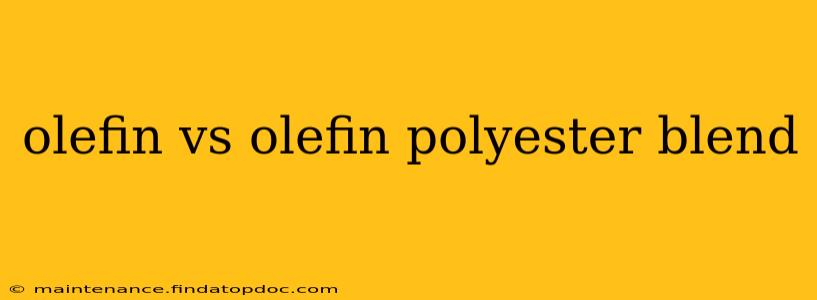Choosing the right fabric for your needs can feel overwhelming, especially when faced with similar-sounding materials like olefin and olefin polyester blends. Both are popular choices for a range of applications, from outdoor furniture to clothing, but their properties differ significantly. This comprehensive guide will break down the key differences between these two materials, helping you make an informed decision.
What is Olefin?
Olefin, also known as polyolefin, is a synthetic fiber made from polyolefin polymers, primarily polypropylene. This gives it a unique set of characteristics. It's renowned for its exceptional durability, water resistance, and resistance to UV degradation. This makes olefin an ideal choice for outdoor applications where it can withstand harsh weather conditions without significant deterioration. It's also lightweight, making it easy to handle and transport.
Advantages of Olefin:
- High Durability: Resists tearing and abrasion.
- Excellent Water Resistance: Dries quickly and resists staining.
- UV Resistance: Withstands prolonged sun exposure without significant fading.
- Lightweight: Easy to handle and transport.
- Affordable: Generally less expensive than many other synthetic fibers.
Disadvantages of Olefin:
- Can Feel Stiff: Lacks the softness and drape of some other fabrics.
- Limited Drape: Doesn't hang as smoothly as other materials.
- Can Be Less Breathable: Not ideal for garments worn in hot and humid climates.
What is an Olefin Polyester Blend?
An olefin polyester blend combines the best qualities of olefin and polyester fibers. Polyester is another synthetic fiber known for its strength, wrinkle resistance, and vibrant color retention. By blending these two fibers, manufacturers create a fabric that often exhibits improved softness, drape, and strength compared to pure olefin. The exact properties of the blend will depend on the ratio of olefin to polyester used.
Advantages of Olefin Polyester Blends:
- Improved Softness and Drape: More comfortable and aesthetically pleasing than pure olefin.
- Increased Strength and Durability: Combines the strength of polyester with the durability of olefin.
- Better Stain Resistance: Benefits from both fibers' stain-resistant properties.
- Retains Color Well: The polyester component enhances colorfastness.
Disadvantages of Olefin Polyester Blends:
- May Not Be as Water-Resistant as Pure Olefin: The addition of polyester can slightly reduce water resistance.
- Potentially More Expensive: Blends generally cost more than pure olefin.
- Recyclability Considerations: Blending fibers can complicate recycling processes.
What are the Best Uses for Olefin?
Olefin's remarkable durability and weather resistance make it a perfect choice for:
- Outdoor furniture: Rugs, cushions, and patio furniture covers.
- Marine applications: Boat covers, awnings, and sails.
- Automotive interiors: Floor mats, upholstery, and trim.
- Some sportswear: Activewear requiring moisture-wicking properties.
What are the Best Uses for Olefin Polyester Blends?
The improved softness and drape of olefin polyester blends make them suitable for a wider range of applications including:
- Clothing: Activewear, sportswear, and casual wear.
- Upholstery: Furniture, automotive interiors, and marine applications.
- Home furnishings: Curtains, drapes, and decorative fabrics.
Which Fabric is Right for Me?
The best choice depends entirely on your specific needs. If durability and weather resistance are paramount, pure olefin is an excellent option. If you need a softer, more comfortable fabric with improved drape and possibly better color retention, an olefin polyester blend might be more suitable. Consider the intended use, budget, and desired aesthetic qualities when making your decision.
How Do I Care for Olefin and Olefin Polyester Fabrics?
Both olefin and olefin polyester blends are relatively easy to care for. Generally, they can be machine washed and dried, although always check the manufacturer's care instructions. Their inherent water resistance and stain resistance make cleaning easier than with many other fabrics.
Is Olefin Recyclable?
The recyclability of olefin and olefin/polyester blends depends on the specific composition and the availability of recycling programs in your area. Check with your local recycling center for information on proper disposal.
This detailed comparison provides a clear understanding of the differences between olefin and olefin polyester blends. By considering the advantages and disadvantages of each, you can choose the ideal fabric for your project. Remember to always check the manufacturer's specifications for specific product details.
